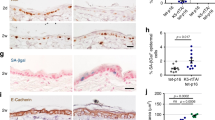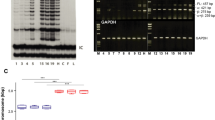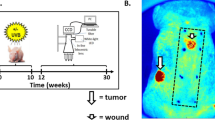Abstract
Multi-stage carcinogenesis (initiation–promotion) was first demonstrated in mouse skin1,2. The first stage, initiation, is accomplished by a low dose of carcinogen that causes no tumours. Promotion by repeated treatment of initiated mice with certain non-carcinogenic hyperplastic agents results in the rapid production of numerous benign papillomas, a few of which progress to squamous cell carcinomas. Although this model system produces mostly benign tumours, many of the concepts concerning carcinogenesis in epithelial tissues have been derived from mouse skin studies. The permanent change in growth potential accomplished by tumour initiators is generally considered to be a mutagenic event3; cell selection and clonal expansion of initiated cells may be involved in promotion4. In initiation–promotion experiments, more than 90% of the squamous cell carcinomas develop from papillomas5,6, but the conversion rate is low. The factors necessary for this conversion of benign to malignant tumours have not been defined but tumour promoters have been assumed to be involved. However, we report here that the tumour promoter 12-O-tetradecanoyl-phorbol-13-acetate (TPA) is ineffective in the conversion of papillomas to carcinomas whereas three initiators, urethane, N-methyl-N′-nitro-N-nitrosoguanidine ((MNNG) and 4-nitroquinoline-N-oxide (4-NQO) are effective. This suggests that malignant conversion may result from a further genetic change in papilloma cells and that the ineffectiveness of TPA may be due to its inactivity as a mutagen.
This is a preview of subscription content, access via your institution
Access options
Subscribe to this journal
Receive 51 print issues and online access
$199.00 per year
only $3.90 per issue
Buy this article
- Purchase on Springer Link
- Instant access to full article PDF
Prices may be subject to local taxes which are calculated during checkout
Similar content being viewed by others
References
Mottram, J. C. J. Path. Bact. 56, 181–187 (1944).
Berenblum, I. & Shubik, P. Br. J. Cancer 1, 383–391 (1947).
Miller, E. C. & Miller, J. A. Cancer 47, 2327–2345 (1981).
Yuspa, S. H. Ben, T. Hennings, H. & Lichti, U. Cancer Res. 42, 2344–2349 (1982).
Shubik, P., Baserga, R. & Ritchie, A. C. Br. J. Cancer 7, 342–351 (1953).
Burns, F. J., Vanderlaan, M., Snyder, E. & Albert, R. E. in Carcinogenesis Vol. 2 (eds Slaga, T. J., Sivak, A. & Boutwell, R. K.) 91–96 (Raven, New York, 1978).
Hennings, H. et al. Cancer Res. 41, 773–779 (1981).
Hennings, H., Bowden, G. T. & Boutwell, R. K. Cancer Res. 29, 1773–1780 (1969).
Saffiotti, U. & Shubik, P. J. natn. Cancer Inst. 16, 961–969 (1956).
Shubik, P. Cancer Res. 10, 713–717 (1950).
Scribner, J. D. & Scribner, N. K. in Carcinogenesis Vol. 7 (eds Hecker, E., Fusenig, N. E., Kunz, W., Marks, F. & Thielmann, H. W.) 13–18 (Raven, New York, 1982).
Verma, A. K. & Boutwell, R. K. Carcinogenesis 1, 271–276 (1980).
Colburn, N. H. in Neoplastic Transformation in Differentiated Epithelial Cell Systems In Vitro (eds Franks, L. M. & Wigley, C. B.) 113–133 (Academic, New York, 1979).
Roe, F. J. C., Carter, C. L., Mitchley, B. C. V., Peto, R. & Hecker, E. Int. J. Cancer 9, 264–273 (1972).
Moolgavkar, S. H. & Knudson, A. G. Jr J. natn. Cancer Inst. 66, 1037–1052 (1981).
Potter, V. R. Carcinogenesis 2, 1375–1379 (1981).
Yuspa, S. H., Hennings, H. & Lichti, U. J. supramolec. Struct. 17, 245–257 (1981).
Peto, R. et al. IARC Monogr. on the Evaluation of the Carcinogenic Risk of Chemicals to Humans Suppl. 2, 311–426 (1980).
Gart, J. J., Chu, K. C. & Tarone, R. E. J. natn. Cancer Inst. 62, 957–974 (1979).
Author information
Authors and Affiliations
Rights and permissions
About this article
Cite this article
Hennings, H., Shores, R., Wenk, M. et al. Malignant conversion of mouse skin tumours is increased by tumour initiators and unaffected by tumour promoters. Nature 304, 67–69 (1983). https://doi.org/10.1038/304067a0
Received:
Accepted:
Published:
Issue Date:
DOI: https://doi.org/10.1038/304067a0
Comments
By submitting a comment you agree to abide by our Terms and Community Guidelines. If you find something abusive or that does not comply with our terms or guidelines please flag it as inappropriate.



